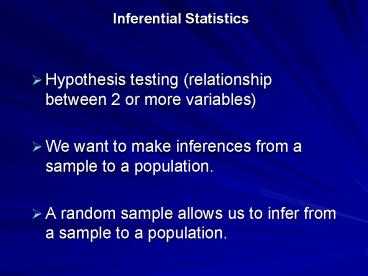Inferential Statistics - PowerPoint PPT Presentation
1 / 22
Title:
Inferential Statistics
Description:
Research question: Does political orientation influence parenting style? ... Parenting style: Permissive & Not Permissive. Why not simply compare the mean difference ... – PowerPoint PPT presentation
Number of Views:48
Avg rating:3.0/5.0
Title: Inferential Statistics
1
Inferential Statistics
- Hypothesis testing (relationship between 2 or
more variables) - We want to make inferences from a sample to a
population. - A random sample allows us to infer from a sample
to a population.
2
Inferential Statistics
- Significance Tests
- Z scores (one sample case)
- Difference of means tests
- Two sample case (t-test)
- Three or more sample case (ANOVA)
- Chi-Square
- Bi-Variate Correlation (One IV One DV)
- Bi-Variate Regression (One IV One DV)
- Multi-Variate Regression (Two or more IVs One
DV)
3
Level of Measurement Significance Tests
- Chi-Square
- IV DV are nominal and/or ordinal
- t-test
- IV is nominal (group like men women)
- DV is Interval/Ratio (or a scale)
- ANOVA
- IV is nominal (group with 3 or more categories)
- DV is I/R (or a scale)
- Regression
- IV(s) DV are I/R (or scales)
- IV(s) can be dummy variables
4
Which Test Would you Use?
- Hr There is a relationship between
- gender income (measured in dollars)
- race (measured as Black, Latino/a,
Caucasian) and income - religious preference (catholic, protestant)
and attitudes toward abortion (favor, oppose) - education (measured in years) and income
- degree completed (HS or Less College) and
income
5
Chi-Square
- Chi-Square a test of significance used with
cross tabulations of nominal/ordinal level data.
6
- Example
- Research question Does political orientation
influence parenting style? - Political orientation Conservative Liberal
- Parenting style Permissive Not Permissive
- Why not simply compare the mean difference
- between liberals and conservatives on parenting
- style?
7
- We are really saying
- Hr The frequency (proportion) of liberals who
are permissive is not the same as the frequency
of conservatives who are permissive. - The null (a hypothesis of no difference) says
- Ho The frequency (proportion) of liberals who
are permissive is the same as the frequency of
conservatives who are permissive.
8
- Chi-Square compares the observed frequencies
(from the data in your sample) to expected
frequencies. - Expected frequencies These are the frequencies
we would expect if the null were true (if there
is no difference between political view and
parenting style)
9
- Example
- We do a cross tab of political orientation by
parenting style and our observed frequencies are - Political Orientation
- Liberals Conservatives
- Child-rearing
- Permissive 5 10
- Not permissive 15 10
- ___ ___
- 20 20
10
- Are these differences significant?
- Chi-Square test of significance
- Chi-Square ?(fo- fe)2 / fe
11
Steps
- Step 1. We have the observed frequencies
- Political Orientation
- Liberals Conservatives
- Child-rearing
- Permissive 5 10
- Not permissive 15 10
- ___ ___
- 20 20
12
Steps
- Step 2. Need to calculate the expected
frequencies. - Formula
- fe (row marginal total) (column marginal total)
- ___________________________________
- N
13
Expected Frequencies
- See board
14
- Step 3. Calculate Chi-Square
- See board
15
- Calculated Chi-Square for Political Views by
Parenting Style - Chi Square 2.66
- Df (r-1)(c-1)
- Df (2-1) (2-1) 1
- Must have a Chi Square of 3.84 at p..05
- to reject the null hypothesis.
- Decision?
16
Review Alpha Levels
- Alpha level the probability of making a Type I
error - Type I error (reject the null when it is true)
- Set alpha level small (.05 or smaller) to
minimize risk. - The larger the sample the smaller the alpha level
should be.
17
- Chi square is sensitive to N (large Ns can yield
significant results) - So, we use a measure of association with
Chi-square - Measures of association tell us about the
- strength of the relationship
18
- Measures of Association
- The type of measure used is determined by the
level of measurement and the number of
categories. - See handout
- Interpret GSS Output
19
Crosstab
20
Chi-Square
21
Measure of Association
- Which should we use?
22
- Cramers V .112































